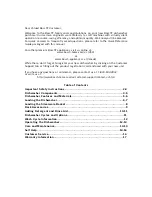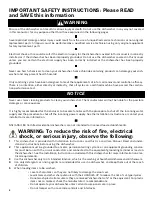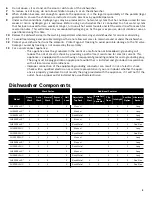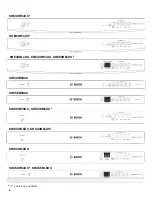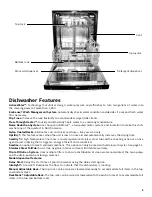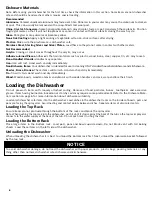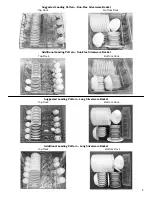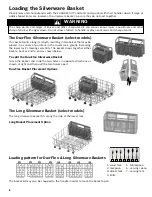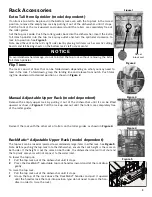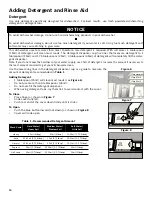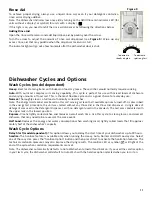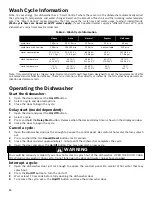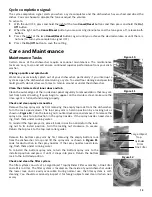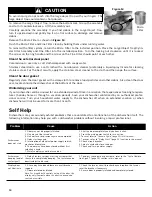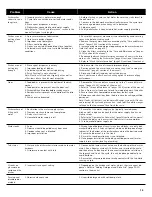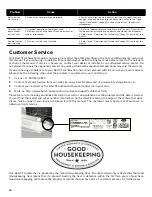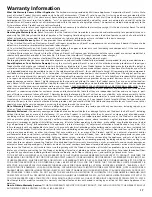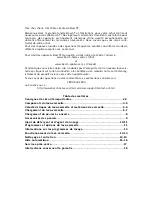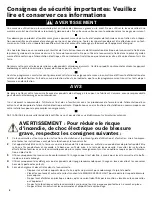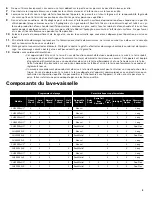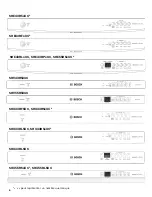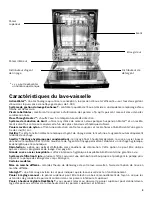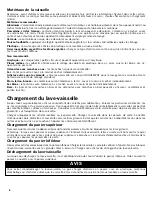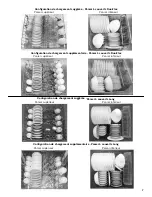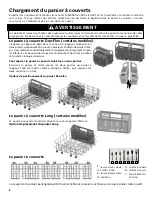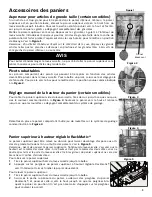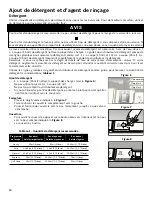
15
Dishwasher
seems to run a
long time
1. Incoming water is not warm enough
2. Cycle time can vary due to soil and water condi-
tions
3. Rinse agent dispenser is empty
4. Dishwasher connected to cold water supply
Note: Refer to “Wash Cycle Information” section in this
manual for typical cycle lengths
1. Before starting a cycle, run hot water faucet at the sink closest to
the dishwasher
2. Sensors in the dishwasher automatically increase the cycle time
to ensure a good wash when heavy soil is detected
3. Add rinse agent
4. Verify dishwasher is connected to hot water supply plumbing
Dishes are not
getting clean
enough
1. Spray arm movement obstructed
2. Spray arm nozzles clogged
3. Improper use of detergents
4. Filters could be clogged
5. Dishes are nested or loaded too close together
6. Selected wash cycle is not suitable for food soil
conditions
1. Ensure that spray arm movement is not blocked by hand rotating
spray arms before starting cycle
2. Remove the spray arms and clean according to the “Care and Mainte-
nance” (pages 13-14) section of the manual
3. Increase or decrease detergent depending on the water hardness
(refer to Table 1 on page 10)
4. Clean the filters according to the “Care and Maintenance” (pages
13-14) section of the manual
5. Rearrange load such that water spray can reach all items in the dish-
washer - see “Loading the Dishwasher” (page 6) section of the manual
6. Refer to “Wash Cycle Information” (page 12) section of the manual
Dishes are not
getting dry
enough
1. Rinse agent dispenser is empty
2. Improper loading of dishes
3. Selected cycle does not include drying
4. Extra Dry Heat is not activated
Note: Plastic or Teflon do not typically dry as well as
other items due to their inherent properties
1. Add rinse aid - the use of rinse aid improves drying
2. Rearrange load to ensure items are not nesting (see “Loading the
Dishwasher” (page 6) section of the manual)
3. Rinse and Hold setting does not include drying
Note: Select models offer an extra heating option to improve drying
performance.
Odor
1. Food debris is present at the bottom of the dish-
washer
2. Food particles are present near the door seal
3. Dishes left in unit too long before running a cycle
4. Residual water is present at the bottom of the dish-
washer
5. Drain hose is obstructed
1. Remove the filters and clean according to the “Care and Mainte-
nance” (pages 13-14) section of the manual
2. Refer to “Care and Maintenance” (pages 13-14) section of the manual
3. Run a Rinse cycle if you do not intend to immediately wash the dishes
4. Ensure the unit has completely drained from the last cycle
5. Remove any obstructions from the drain hose by calling qualified
personnel.
Note: If odor still persists, run the Normal/Regular cycle until it flushes
and interrupt the cycle and place an 8oz. cup of distilled white vinegar
solution on the top rack and then finish the cycle.
Dishwasher not
filling with
water
1. Restriction in the water supply system
2. Previous wash cycle was not completed
3. Delay start is active
4. Household water supply is off
1. Ensure that the water supply valve (typically located under
kitchen sink) is open and check that the water supply line has no
kinks or clogs
2. Refer to the “Operating the Dishwasher” (page 12) section of the manual.
3. Cancel the delay start or wait until delay start time completes
4. Turn household water supply on
Water leaks
1. Suds
2. Door seal could be pulled away from track
3. Condensation vent is blocked
4. Improper installation
1. Wrong type of detergent results in suds and leaks - use only dish-
washer detergents. If suds still persist, add one tablespoon of vege-
table oil at the bottom of the dishwasher and run the desired cycle.
2. Ensure the door seal is in the track
3. Ensure that condensation vent is not blocked
4. Have proper installation verified by qualified personnel (water
supply, drain system, leveling, plumbing)
Tub stains
1. Stains on the dishwasher interior are due to water
hardness
2. Silverware in contact with tub
1. Concentrated lemon juice can reduce the build up of hard water
stains. Run a Regular cycle until it flushes and interrupt the cycle
and then place an 8oz. cup of the concentrated lemon solution on
the top rack and finish the cycle. this can be done periodically to
avoid build up.
2. Ensure that silverware does not make contact with the tub while
running a cycle.
Streaks on
glassware or
residue on the
dishes
1. Incorrect rinse agent setting
1. Depending on the hardness of water, adjust the rinse agent dis-
penser. Refer to “Adding Detergent and Rinse Aid” (page 10-11)
section in the manual
Fascia panel
discolored or
marked
1. Abrasive cleaner used
1. Use mild detergents with soft damp cloth
Problem
Cause
Action

